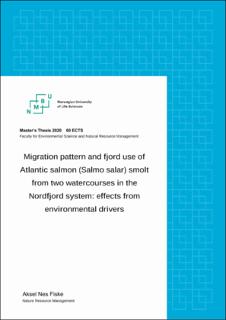| dc.description.abstract | As a part of its complex life cycle, wild Atlantic salmon (Salmo salar) smolts must migrate from its natal river into marine residency for feeding and maturing, for then to return as adult salmon after 1-4 years. This capricious migration, characterized by high mortality rates, has possibly become even more grueling as the burden of human engagements increases in various ways such as increased infestation pressure from salmon lice (Lepeophtheirus salmonis) due to farmed Atlantic salmon. It is therefore important to map the timing of migration and the mortality rates along the migration course, to understand the effects inflicted by these human engagements. The purpose of this study was to explore effects from migration triggers- and patterns, fjord progression speed and survival of smolt from Eidselva and Stryneelva watercourses, both emptying into the Nordfjord system by use of acoustic telemetry. Smolts were captured and tagged at two sites from both watercourses, and in both of these watercourses the capture-sites were separated by a large lake. In Hornindal watercourse, smolts were caught upstream and downstream of Hornindalvannet in the rivers Horndøla and Eidselva respectively. In Stryneelva watercourse, smolts were caught upstream and downstream of Oppstrynvannet in Hjelledøla and Stryneelva respectively. In total,147 out of 199 (73.9 %) of the tagged smolts were later detected at one or more receivers throughout the study system. As the smolts tagged with acoustic transmitters migrated through the study system, from river to outer part of Nordfjord, they were detected at fixed receiver stations all along the migration course. I hypothesized that increasing water discharge- and temperature are the most important environmental cues for triggering smolt migration, and that migration will occur at multiple migration-peaks. The smolts will display a uniform, continuous migration pattern out of the fjord, and to little extent display vertical depth migrations. That smolt mortality will vary through the entire study system and that the mortality rates will be higher for smaller smolt.
The initiation of seaward migration for tagged smolts was found to correlate with combined effects of increased water discharge and day of year. In Eidselva, initiation of migration was correlated with day of year, water discharge and the relative change in water discharge from the previous day to the next. Migration initiation in Stryneelva was correlated with day of year and relative change in water discharge from the previous day. For both watercourses the smolts migrated at two major migrations peaks separated by 3.5 weeks, with one minor migration-peak in between. The median migration date for when the smolts entered the estuary from both watercourses was separated by 10 days, with median migration date 11th of May for Hornindal watercourse and 1st of May for Stryneelva.
For smolts migrating from Stryneelva, apparent survival bottlenecks were related to the estuary of Stryneelva (33.6 % estimated survival) and the outermost part of the fjord system (25.5 % estimated survival). In Eidselva, however, there only seems to be a slight decrease of apparent survival in the estuary (93 % estimated survival) compared to the rest of the fjord. For the entire study system, the estimated survival rates from river to outer parts of the fjord varied from 19.6 % confirmed survival (Eidselva) to 24.2 % confirmed survival (Stryneelva). For comparison, the previous studies in the same study system found no bottlenecks and estimated survival rates were found to be higher than 98 % in 2018. The survival rates were found to positively correlate with body length, as longer smolts migrating from Stryneelva had better predicted survival rates through their entire migration course. The same correlation was found in the estuary of Eidselva exclusively, for smolts migrating from the Hornindal watercourse. Most of the smolts entered marine residency after sunset but before midnight, and migrated out of the fjord at various progression speeds, depending on time of migration and river of origin. Both migration groups from Eidselva migrated with the same progression speed, being 0.86±0.09 BL/s. The first smolt group that migrated from Stryneelva displayed progression speeds of 0.92±0.10 BL/s, whereas the last group migrated at 2.42±1.07 BL/s. Migrating at these speeds, the Eidselva-smolt reached the outer part of Nordfjord after an average of 4.43±4.13 days, and the respective number of days for the Stryneelva-smolt was 9.48±3.85 days. The migration rate appeared to be quite linear throughout the fjord for smolts from both watercourses, indicating a uniform, continuous migration pattern, utilizing almost exclusively depths shallower than 2 meters. Diurnal depth migrations did not appear to occur extensively, as there was only a slight tendency of depth migrations in the estuary of both rivers.
This study has helped increase the knowledge about migration patterns and triggers, and survival rates for salmon smolts migrating from Hornindal and Stryn watercourse in Nordfjord, and highlights the variety in survival rates from year-to-year in such dynamic systems. | en_US |

